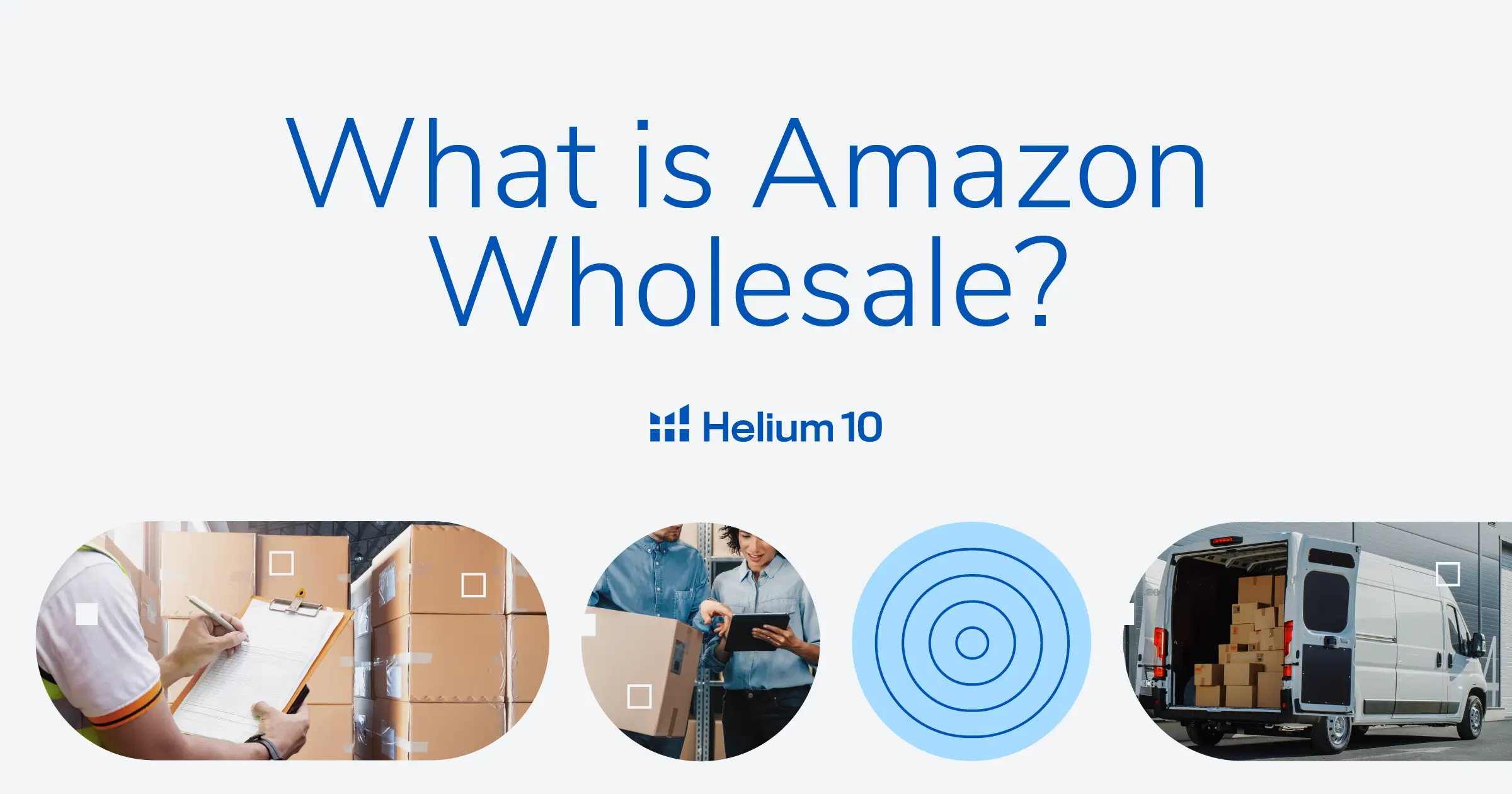
Amazon Wholesale: A Comprehensive Guide to Selling Products in 2023


Table of Contents
- Introduction
- What Is Amazon Wholesaling?
- How Does Amazon Wholesaling Work?
- What Are the Pros and Cons of Amazon Wholesaling?
- How Is Wholesaling Different From Retail Arbitrage?
- Is It Profitable to Be an Amazon Wholesaler?
- How Much Do Amazon FBA Wholesalers Make?
- How Much Money Do You Need to Start Wholesaling on Amazon?
- Where Do You Buy Products to Wholesale on Amazon?
- What Are the Best Categories to Sell Wholesale on Amazon?
- How Do I Figure Out Which Products Are Good Candidates for Amazon Wholesaling?
- How to Get Started With Amazon FBA Wholesale
- Conclusion
Introduction
Being an Amazon wholesaler means you’re the middleman between an established factory that makes your product and the people who really want it. You get to sell something that comes at a reduced upfront purchasing price, have decent profit margins, and less work for yourself on the shipping and logistics side of things in the long run because Amazon helps you make it all happen smoothly.
Have I caught your attention? Good, you’ll want to stick around for this.
Outclass Your Competitors
Achieve More Results in Less Time
Maximize your results and drive success faster with Helium 10’s full suite of Amazon and Walmart solutions.
Sign Up for FreeWhat Is Amazon Wholesaling?
Let’s discuss Amazon wholesaling through the story of Sarah, an enterprising individual entering the Amazon wholesale business. Sarah’s primary objective is to sell wholesale products on Amazon, and unlike Amazon FBA private label sellers, she doesn’t aspire to create her own brand. Instead, she’s eager to offer established brands to Amazon’s massive customer base. Sarah embarks on her journey armed with a commitment to product research to spot items in high demand while ensuring competitive profit margins.
Sarah’s initial steps involve establishing connections with suppliers and manufacturers, a critical aspect of her Amazon wholesale business. She actively reaches out to various suppliers, ranging from local manufacturers to retail stores, securing a consistent and diverse supply of goods. Her focus remains steadfast on maintaining a reliable inventory flow to meet the growing demands of Amazon’s online shoppers.
With her products procured, Sarah lists them on Amazon, joining the league of multiple sellers all vying for visibility on the same products and, most importantly, the coveted “buy box.”
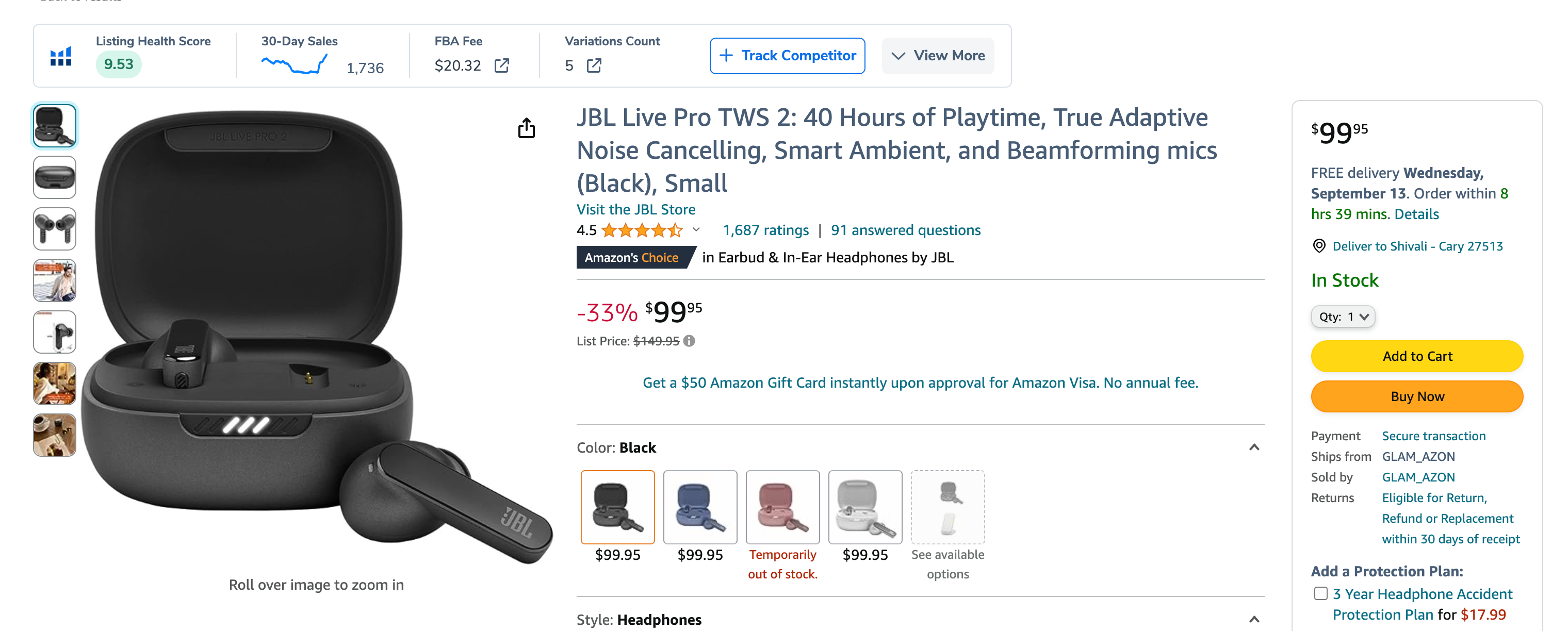
This buy box, or the Buy Now button, plays an important role in influencing sales for the bottom line of her business, making it that much more vital for her to continuously assess factors such as pricing, product presentation, and number of sellers on the same listing to stay competitive in the marketplace.
By facilitating the distribution of wholesale goods, she bridges the gap between suppliers and online sellers, contributing to the dynamic ecosystem of Amazon and epitomizes being an intermediary in Amazon wholesaling. Her commitment to in-depth product research, maintaining profit margins, and fostering robust relationships with suppliers sets the stage for her success in the e-commerce business space. In turn, established brands find new life and reach a global audience.
How Does Amazon Wholesaling Work?
Of course, the first step will be sourcing products from manufacturers or suppliers in bulk while negotiating favorable terms. If needed, you can also turn to a product research tool like the Products tab located inside Helium 10’s Black Box to uncover product opportunities.
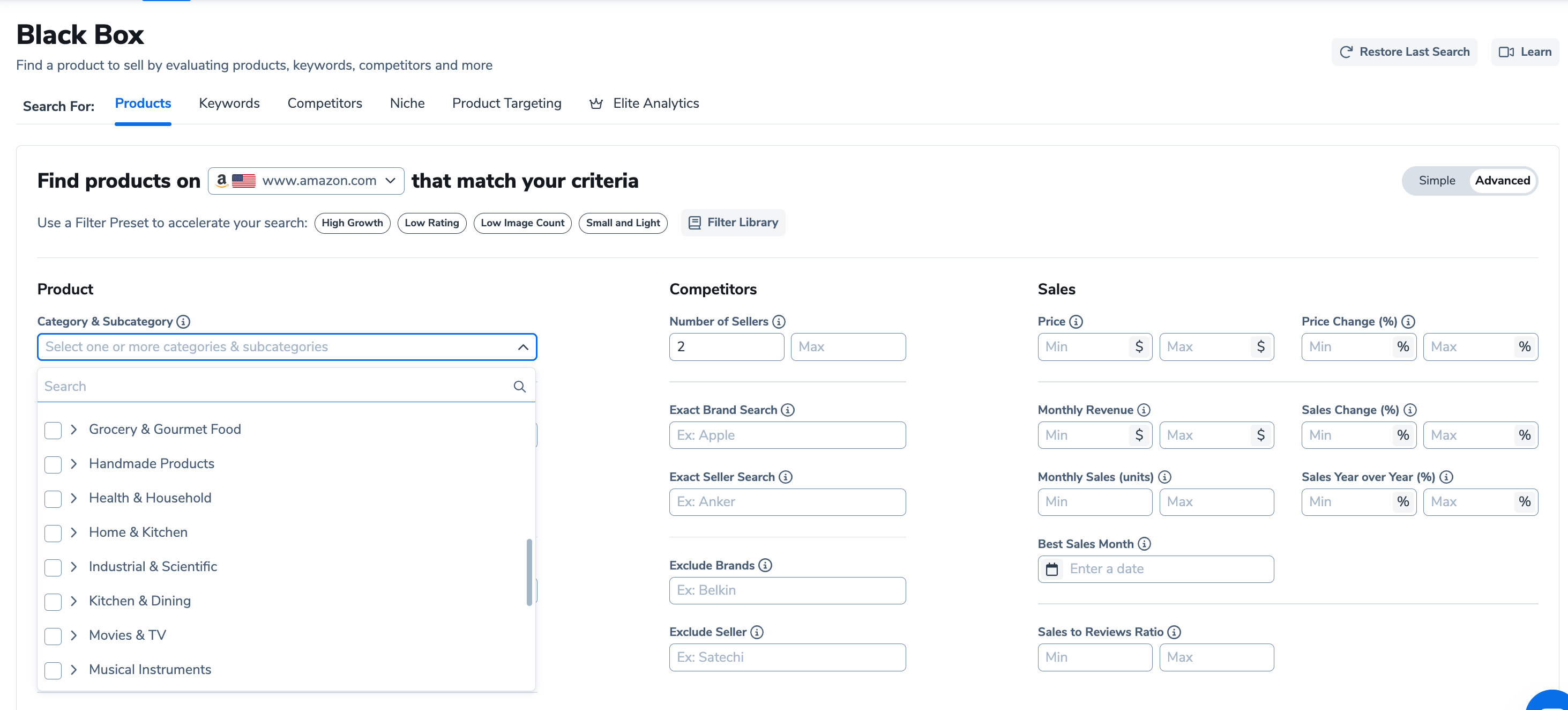
Using filters listed below the Competitors section will serve you well if you are trying to find wholesale products to sell. Inputting a minimum of 2 sellers will help you eliminate products that are private label products and focus on wholesale products and arbitrage.
Similarly, if you are aware of a particular seller or brand to model your Amazon business after, you can use the “Exact Brand Search, Exact Seller Search, Exclude Brands (and) Exclude Seller” filters to quickly hone in on profitable products that could help you boost your wholesale business.
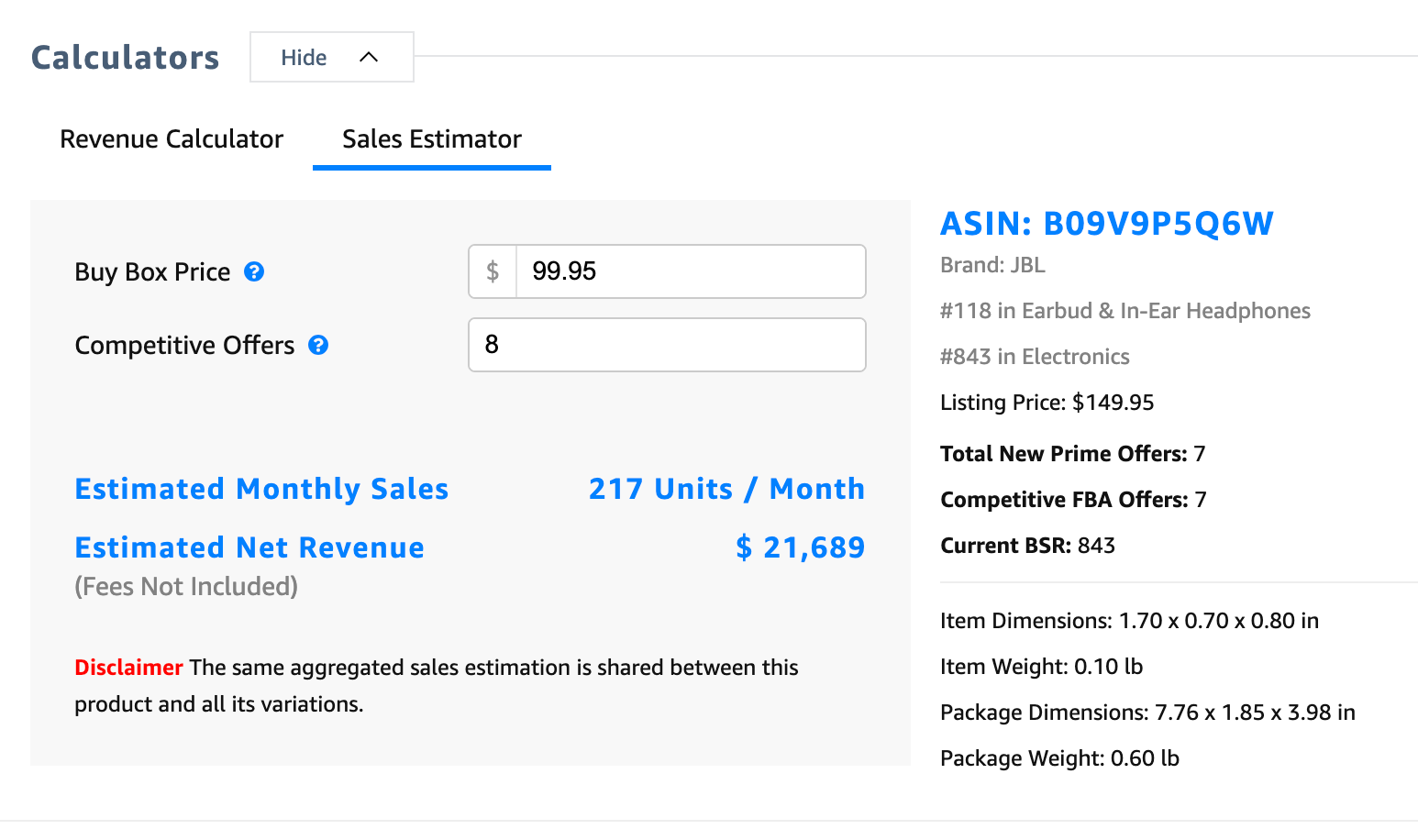
Just be sure to open up the product page upon being outputted results and use our Sales Estimator (you’ll need to have our Chrome Extension installed to have access to this) to gauge your estimated monthly sales and net revenue if you were to rotate the buy box with the current competitive FBA offers.
From there, once you have established a product and an agreement has been reached with your manufacturer or supplier, you can establish an Amazon seller account if you don’t have one already and create product listings with detailed descriptions, attractive images, and competitive prices.
In the long run, balancing costs, fees, and profit margins while managing your inventory will help you avoid stockouts or overstocking. Stockouts, an out-of-stock (OOS) situation, is when a retailer or business depletes its inventory of a particular product and the product is temporarily unavailable for purchase by customers. This contrasts with overstock, which references the presence of an excessive amount of inventory on hand compared to the demand for those products.
In other words, when a stockout happens be it from high demand, supply chain disruptions, inaccurate inventory management, manufacturing delays, or unexpected spikes in customer orders, the product is no longer in stock and cannot be immediately fulfilled or sold to customers who want to purchase it. They are generally considered undesirable by businesses as they can lead to lost sales, dissatisfied customers, and potential damage to a company’s reputation.
You’ll need to decide whether to use Amazon’s Fulfillment by Amazon (FBA) service or handle shipping yourself through Fulfillment by Merchant (FBM). Effective sales and marketing strategies, including optimizing your listings and using advertising, can help attract customers. Providing excellent customer service and promptly addressing any issues maintains your seller’s reputation.
Continuously monitor your sales performance, customer feedback, and other metrics to make informed adjustments to your strategies. As you gain experience and success, consider expanding your product range and business operations for growth and stay up-to-date with Amazon’s latest seller guidelines and policies, as they can change over time. This journey demands careful planning, consistent effort, and adaptation, but it is possible to make substantial income from selling wholesale.
What Are the Pros and Cons of Amazon Wholesaling?
Shivali, you mentioned careful planning…so could you share a bit about the pros and cons of wholesaling?
Absolutely! By now, I think I’ve cemented Amazon wholesaling presents a myriad of opportunities and challenges for those seeking to expand their Amazon business.
Among its advantages, the wholesale business model allows sellers to offer established brands, tapping into Amazon’s massive customer base, which is perfect for those learning how to increase sales on Amazon. Leveraging Amazon’s Fulfillment by Amazon (FBA) service can be transformative, streamlining storage, packaging, and shipping and thus saving sellers valuable time and effort. An additional inherent benefit of selling on Amazon is the platform’s credibility, as customers trust it for dependable shopping experiences. Amazon’s highly efficient logistics network ensures products are delivered smoothly and promptly, elevating the overall customer experience. Not to mention, Amazon provides valuable marketing tools and advertising options, empowering sellers to enhance their product’s visibility and boost sales. With Amazon’s global reach, the market extends beyond borders, granting access to international customers.
Nonetheless, there are potential pitfalls associated with Amazon wholesaling. The platform’s immense popularity translates into stiff competition among sellers, which can lead to price wars and put pressure on profit margins. Amazon imposes various fees, including referral and FBA fees, which can impact a seller’s overall profitability if the seller is not careful. You may also grapple with the challenge of limited control over their brand’s presentation and customer data, as Amazon has strict guidelines and policies you must adhere to.
The best way to battle the latter issue is through the use of authentic, quality products and the use of product inserts to build trust and mitigate issues related to returns or negative feedback.
This all goes to say Amazon offers a robust platform for reaching a broad audience with established brand-name products. However, sellers must conduct thorough research, secure the necessary wholesale license, and diligently contact suppliers to navigate these advantages and disadvantages effectively. Leveraging Amazon’s rich supplier directory may prove helpful in finding wholesale suppliers who can provide a consistent supply of quality products.
Increase Your Profits and Decrease Your Workload with Diamond
Experience AI-enhanced tools, expanded data limits, time saving automations, and improved integration between your favorite Helium 10 tools.
How Is Wholesaling Different From Retail Arbitrage?
Now, if you are a bit confused about understanding what the difference between wholesaling and retail arbitrage is, then you are not alone. Both are methods of sourcing and selling products, but they involve different approaches and strategies.
Wholesaling involves purchasing products in bulk directly from manufacturers, distributors, or suppliers at a discounted wholesale price, often with the intention of selling them in significant quantities to other retailers or individual customers. Wholesalers tend to have more control over the products they sell, as they purchase them in advance and can brand or package them according to their business needs and the method focuses on building stable relationships with suppliers for a consistent supply of products over time. When it comes time to scale, wholesalers can do so by leveraging economies of scale and managing larger inventories.
This compares to retail arbitrage which involves finding discounted or clearance products from retail stores, online marketplaces, or other sources, and then reselling them at a higher price. Retail arbitrage doesn’t involve buying products in bulk, but rather buying individual units. Arbitrageurs buy products on a retail level, often taking advantage of sales or discounts, and heavily rely on finding underpriced items in one market and reselling them at a higher price in another market, capitalizing on price differences. Arbitrage is an opportunistic approach that offers flexibility as it doesn’t require establishing relationships with manufacturers or committing to larger quantities of inventory. However, this also means retail arbitrage sellers have less control over branding and packaging, as they are often selling the products in their original condition. Scalability challenges maybe you become limited by the availability of discounted products, making it more challenging to scale the business consistently.
Basically, wholesaling involves purchasing products in bulk at wholesale prices and distributing them to retailers or customers. Retail arbitrage involves finding and buying discounted individual products to resell them for a profit.
Both methods have their own advantages and challenges, and the choice between them often depends on your business goals, resources, and preferences.
Is It Profitable to Be an Amazon Wholesaler?
Yes, but success depends on quite a few things.
Your profit margins, determined by sourcing products at favorable wholesale prices from reliable wholesale suppliers and setting competitive retail prices on Amazon, play a significant role as does competition within your chosen product category.
If there are many other Amazon sellers on your listing, the demand for your products and the volume of sales you can generate may be split too thin to be profitable. That’s without accounting for Amazon’s fees, such as referral and fulfillment fees, which must also be factored in.
Some things that can boost your profit margins are efficient inventory management skills, strong supplier relationships, effective branding, differentiation efforts, whether through selling established brands or private label products and bulk purchases of high-demand or branded products that can boost your margins further.
Regardless of the time and effort you take to make the right decisions, you shouldn’t skimp on monitoring market trends, employing smart marketing strategies, and staying informed about Amazon’s policies to stay ahead and sustain profitability with the wholesale business model. Careful planning and adaptable strategies are the keys to achieving and maintaining profitability over time with Amazon wholesaling.
How Much Do Amazon FBA Wholesalers Make?
There’s no way to really say. The earnings of Amazon FBA wholesalers, operating within the Amazon wholesale business model, can vary significantly based on factors like product profitability, market competition, sales volume, operational efficiency, and costs.
Profit margins depend on the difference between product costs and selling prices minus Amazon fees. Niches with less competition might yield better margins, and high sales volume can offset lower margins. Costs such as shipping, packaging, and advertising should also be considered. Efficient operations, seasonal demand, product diversity, branding, and differentiation, whether through selling established brands or developing your own brand, all play roles in determining earnings. However, there’s no fixed income, and the best way to really put it is success in the realm of selling wholesale products on Amazon just depends on a combination of factors unique to each wholesaler’s business. However, having the necessary business license will always remain a fundamental requirement for engaging in Amazon wholesale.
How Much Money Do You Need to Start Wholesaling on Amazon?
Here’s a breakdown of what you should consider to get a good picture of how much money you need to start selling wholesale:
1. Inventory Costs: Your initial investment will largely depend on the cost of the products you plan to purchase in bulk. This can range from hundreds to thousands of dollars, depending on the type of products and the quantity you want to start with.
2. Minimum Order Quantities: Many wholesalers require minimum order quantities to get discounted prices. Be prepared to meet these minimums, which can impact your upfront costs.
3. Amazon Seller Account Fees: Amazon charges fees for selling on its platform. The two main plans are the Individual Plan (per-item fees) and the Professional Plan (monthly subscription fee). The Professional Plan is generally more cost-effective for wholesalers due to the higher volume of sales they aim for.
4. Shipping to Amazon: If you plan to use Amazon’s FBA service, there will be costs associated with shipping your products to Amazon’s fulfillment centers.
5. Packaging and Labeling: Depending on the products you’re selling, you might need to invest in proper packaging and labeling to meet Amazon’s requirements.
6. Advertising and Marketing: Allocating a budget for advertising and marketing efforts can help you promote your products and attract customers.
7. Initial Marketing and Promotions: Offering discounts or promotions when you launch can help jumpstart sales and visibility, but it requires some initial investment.
8. Software and Tools: You might consider using software for inventory management, analytics, and other aspects of your business, which could come with associated costs.
9. Operating Expenses: Remember to account for ongoing operational expenses such as internet, office supplies, and any other costs associated with running your business.
The total startup costs can range from a few hundred to several thousand dollars, and sometimes even more, depending on the scale of your operation and the products you’re dealing with. Careful budgeting and planning are crucial to ensure that you have enough funds to cover all necessary expenses and effectively launch your Amazon wholesaling business. It’s also advisable to start small, test the waters, and gradually scale up as you gain experience and confidence in your business model.
Where Do You Buy Products to Wholesale on Amazon?
You can find products wholesale on Amazon from a variety of sources. One option is to buy directly from manufacturers, which often offers the best pricing. Establishing relationships with manufacturers can be done through trade shows, events, or online directories.
You can turn to a distributor. Distributors are middlemen who purchase from manufacturers and sell to retailers, including wholesalers.
Trade shows and exhibitions in your industry are excellent places to explore local suppliers and wholesalers for sourcing products and building good relationships.
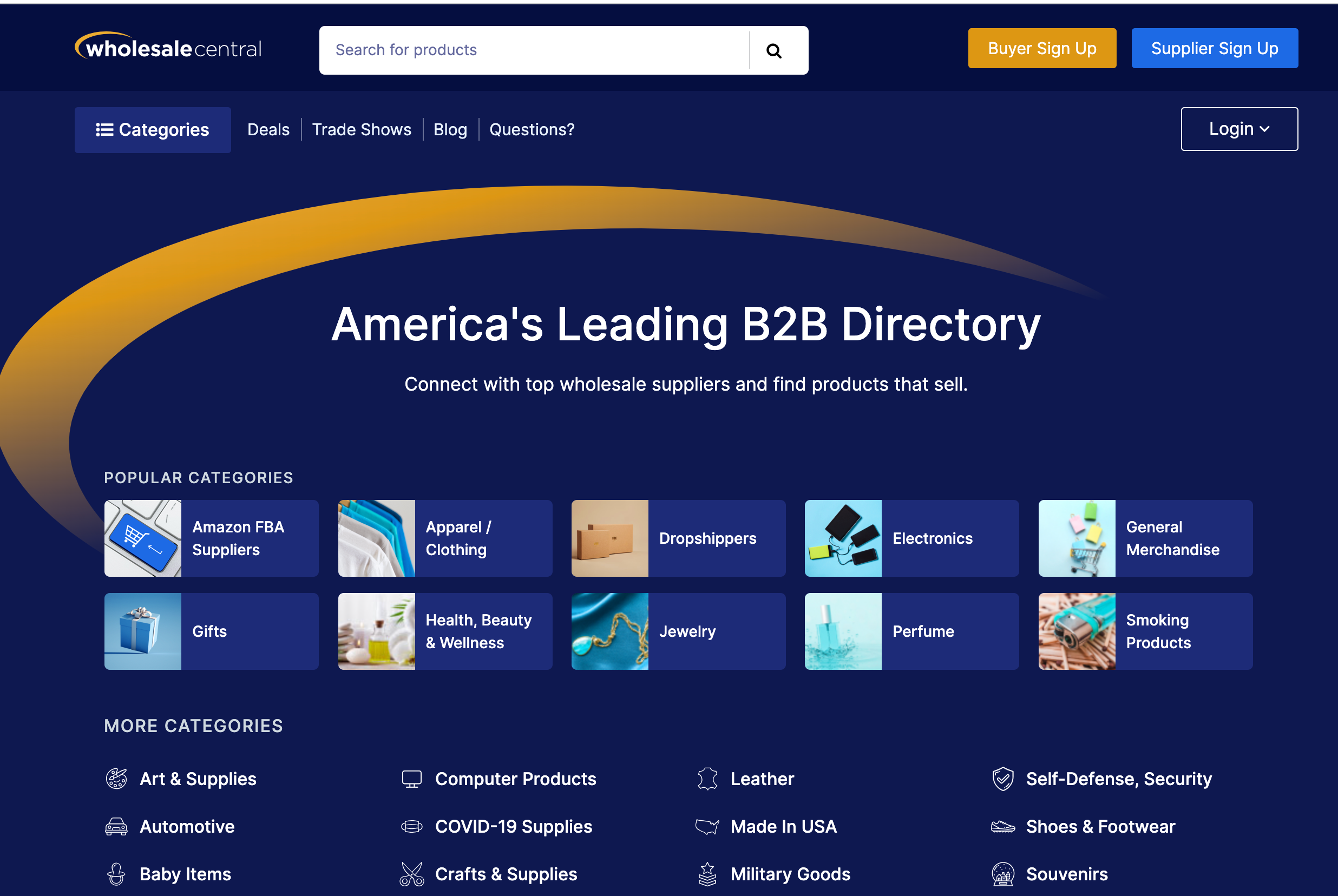
However online platforms and directories like WholeSale Central, Alibaba, Thomasnet, and Global Sources can also help you identify potential suppliers. Some wholesalers engage in private labeling (aka me, hello), purchasing generic products, and rebranding them.
When sourcing, consider factors such as quality, pricing, shipping costs, minimum order quantities, and the reliability of suppliers. Establishing strong relationships with suppliers is vital for a successful wholesale business. It’s wise to research thoroughly, verify supplier credibility, and start with smaller orders to ensure a smooth entry into the wholesale market.
What Are the Best Categories to Sell Wholesale on Amazon?
The best categories to sell wholesale on Amazon depend on who is asking. Someone with more upfront investment capital may feel it is suitable to venture into electronics items, but someone who cannot afford to bulk purchase higher investment items may not.
Take a look at your limitations, business goals, market trends, competition, demand, and your own expertise before settling on a category. However, what I can tell you is though popularity can change over time, some categories tend to perform better than others due to their consistent demand and broad customer base and they are:
- Electronics: Items like tech accessories, gadgets, and electronics have consistent demand. However, competition can be high.
- Home and Kitchen: This category includes a wide range of products like kitchen gadgets, home decor, and appliances. There’s a steady demand for practical and decorative items.
- Toys and Games: Toys, games, and hobbies are popular throughout the year, especially during the holiday season.
- Beauty and Personal Care: Skincare, cosmetics, and grooming products have a dedicated customer base.
- Health and Wellness: Products related to fitness, health, and well-being are sought after, especially as people become more health-conscious.
- Baby Products: Items like baby gear, clothing, and accessories are in constant demand due to the ongoing needs of parents.
- Apparel and Accessories: Clothing, shoes, and fashion accessories can be profitable, though they might require careful branding and differentiation.
- Sports and Outdoors: Sporting equipment, outdoor gear, and related accessories have a market of enthusiasts and athletes.
- Pet Supplies: Pet care products and accessories cater to a large and passionate pet owner community.
- Office Products: Stationery, office supplies, and organizational tools are always needed by businesses and individuals.
Increase Your Profits and Decrease Your Workload with Diamond
Experience AI-enhanced tools, expanded data limits, time saving automations, and improved integration between your favorite Helium 10 tools.
How Do I Figure Out Which Products Are Good Candidates for Amazon Wholesaling?
Identifying suitable products for Amazon wholesaling requires a strategic approach. Here’s a step-by-step guide to help you determine which products are good candidates:
1. Market Research: Begin by researching various product categories on Amazon. Look for niches with steady demand and a reasonable number of sales. Tools like Amazon Best Sellers and product research software (using Black Box the way I showed you above) can provide valuable insights.
2. Competition Analysis: Evaluate the level of competition for potential products using Sales Estimator and take time to read the reviews on competitor listing pages. A balance between demand and manageable competition is essential. Avoid overly saturated markets where standing out is difficult.
3. Profit Margins: Calculate potential profit margins by factoring in the cost of goods, Amazon’s fees, shipping expenses, and any other associated costs. Ensure that your margins allow for a healthy profit.
4. Sales Rank and Trends: Examine the sales rank of products to gauge their popularity. Additionally, analyze historical trends to determine if demand is consistent or seasonal. You can do this by popping open those graph icons located next to Monthly Sales and/or Search Volume inside our Chrome Extension, Black Box, and Cerebro tools.
5. Customer Reviews: Study customer reviews for similar products to understand customer satisfaction, identify pain points, and discover potential improvements. Add value to the existing market in any way you can.
6. Product Differentiation: Consider how you can differentiate your offerings. Unique features, enhanced quality, appealing packaging, or bundling can set your products apart.
7. Supplier Assessment: Research potential suppliers or manufacturers. Assess their reliability, production capacity, quality control, and ability to meet your requirements consistently.
8. Minimum Order Quantities: Check if suppliers have minimum order requirements and ensure they align with your budget and storage capabilities.
9. Legal and Safety Compliance: Ensure that selected products meet all legal and safety regulations for selling on Amazon.
10. Longevity and Trends: Assess if the products have long-term appeal or are merely trendy items. Favor products with lasting demand over fleeting fads.
11. Scalability: Consider whether you can scale up your operations as your business grows. Products that allow for scalability can be more profitable in the long run. Ask, “How can I keep up?”
12. Personal Interest and Knowledge: While not mandatory, having personal interest or expertise in a product category can be advantageous for effective marketing and customer engagement.
13. Brand Potential: Evaluate if there’s potential to build a strong brand around the chosen products, enhancing your differentiation and customer loyalty.
14. Risk Assessment: Understand the risks associated with each product, including potential oversupply, changing market dynamics, or shifts in customer preferences.
By thoroughly assessing these factors, you can identify products with strong potential for successful Amazon wholesaling. Keep in mind that continuous research, adaptation, and monitoring are essential to navigate the ever-evolving e-commerce landscape effectively.
How to Get Started With Amazon FBA Wholesale
Here’s a five key tips summary to get started with Amazon FBA wholesale:
- Thorough Research: Research product categories, suppliers, and market trends to identify profitable opportunities. Choose a niche that aligns with demand and your interests.
- Strong Supplier Relationships: Build reliable relationships with suppliers who offer quality products and competitive pricing. Negotiate terms and ensure they can meet your order requirements.
- Optimized Listings: Create compelling product listings with clear titles, detailed descriptions, and high-quality images. Use keywords to enhance discoverability.
- Effective Marketing: Utilize Amazon advertising and external marketing channels to increase product visibility. Engage with customers and provide exceptional service.
- Continuous Improvement: Regularly analyze data, adjust pricing, and optimize inventory levels based on sales performance. As you gain experience, expand your product range and refine your strategies.
Starting with these tips will help you establish a solid foundation for your Amazon FBA wholesale business and set you on the path to success.
Conclusion
And that’s a wrap on our journey through Amazon wholesale in 2023!
We hope you’ve found this guide to be a trusty companion as you navigate the exciting world of e-commerce. Selling products on Amazon is like embarking on a grand adventure – full of twists, turns, and new discoveries. With the insights you’ve gained here, you’re ready to take on the challenges and seize the opportunities that come your way. You can always subscribe to our Serious Sellers Podcast too to listen to new updates on the go whenever we have them.
And remember, success is about more than just numbers; it’s about connecting with customers, building your brand, and creating a business that brings you joy.
So whether you’re a seasoned seller looking to level up or a newbie taking your first steps, here’s to embracing the possibilities that Amazon wholesale brings and crafting your own success story.
May you find success!
Frequently Asked Questions
Achieve More Results in Less Time
Accelerate the Growth of Your Business, Brand or Agency
Maximize your results and drive success faster with Helium 10’s full suite of Amazon and Walmart solutions.
